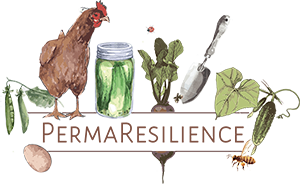Are you exhausted from spending all of your free-time time in your garden? Here’s how you can spend less time in your garden and still grow a ton of veggies. These permaculture tips will help you create a low-work homestead that requires about 15 minutes a day.
Video Transcript:
So it is true that gardening, specifically conventional gardening, and even organic gardening, takes way too much time, and this is a big problem that I hear everybody talk about. But the reality is that it doesn’t have to. There’s an alternative.
Hey everyone, Brett James here. If you’re a person who struggles with time when it comes to gardening, I want to talk about that specifically because I’ve had that experience in the past, but it doesn’t have to be the case.
Like example, I remember working on an organic farm and I questioned all the things that we were doing that seemed to take so much time, like picking all the little tiny weeds out of the rows between the plants. But it doesn’t necessarily have to be the case. As I was saying, I’ve had gardens that have been very little work after your initial planting.
All throughout the season, just do a little bit of maintenance, and then in the fall, you have a big massive abundant harvest. So I’m going to talk about how you can do that here in this video.
Now, for those of you who have not been following along, we just purchased the straw bale home on five acres, and it has an existing garden, or even if I dare to call it a food forest.
It is February right now, so obviously there’s not much going on. What I want to talk about here is even if we didn’t plant this garden full of annuals for the season, there would still be tons of food growing in this garden.
And yes, I get it, if you know your garden takes all your time and energy, and then you get a minimal harvest or yield out of it at the end of the season, it can be very frustrating, defeating, and just kind of make it seem like, what’s the point?
But again, it doesn’t have to be that way. So in this video, I want to talk about the five different ways in which permaculture can drastically shift your garden from a burdensome time suck of a place, and shift your garden to an efficient, abundant oasis, where you get incredible harvests for not a lot of time and energy. And also at the end of the video here, I’ll throw in a six bonus strategy that I think is the most important out of any of them. So stay tuned until the end for that. Alright, so in a low-work permaculture garden, the first thing that we do is do not till.
Okay, now there are exceptions to that rule, but by and large, the thing that we don’t do is go through our garden every season, bust out a tiller, and tear up the soil, destroying the soil life. Because that wastes a ton of time, and in the end, it actually degrades your soil and makes growing in the seasons to come to a lot harder.
So we don’t till in the permaculture garden, and by not tilling, we save a ton of time, energy, fossil fuels, and sometimes even our toes. Real quick, if you’re liking the content here, the llama is asking you to consider liking the video because it’s a free way that you can support the channel. And if you want to see more of these in your YouTube feed, be sure to hit the subscribe and notification buttons as well.
Second, in the permaculture garden, we typically don’t need to spend time battling pests and diseases. This is because we invest a little bit of time and energy upfront to building healthy soils, so that way pests are not necessarily a problem in the garden.
All of the gardens I’ve had never really had pest issues, not like I’ve lost entire gardens or full crops to aphids or anything like that. So, by focusing on improving our soil quality, and our soil health, we have healthier plants that are more pest-resistant, saving tons of time.
Third, we have a few problems with weeds in the garden, and that’s because of a variety of different things. For one, we tend to cover up bare soil so that way weeds can’t necessarily become prolific in those areas.
Second, by building our soils and creating healthy soils, we actually create conditions where it’s less desirable for weeds to grow. So, then we have less of a weed problem in that way. And also, the thing to understand is that weeds, actually, as we call them, they’re not necessarily harmful.
A lot of weeds create benefits in the garden, and sure, there are some weeds that we don’t necessarily want to let run rampant in the garden, like Johnson grass, but other weeds like purslane, actually help improve the soil quality.
So in the permaculture garden, we can identify what weeds to keep and use strategies to prevent them from even growing, thereby saving a ton of time and not needing to do one of the lamest tasks there is in the garden, which is weeding.
Fourth, in the low-work permaculture garden, we don’t waste tons of time dealing with watering issues. We do this by automating our irrigation systems so that way we don’t have to be hand watering everything in the garden, and we can step away from our gardens and not worry about the watering not happening right.
Also, building healthy soils as I’ve been talking about, saves us time when it comes to watering too because the soils have a greater water-holding capacity, and so they retain the moisture longer.
Additionally, in the permaculture garden, we don’t have bare soil, so we always cover the soil in mulches, and by doing this, we can reduce the evaporation of water out of our soil by up to 90 percent, which then increases the resiliency of the garden and the amount of time that we need to deal with watering, in addition to conserving water, so double win there.
Our fifth time-saving strategy for a low-work permaculture garden is that we focus on designing, planting, and building what we might call food forests. And I know it’s hard to tell here because we’re in February and the garden really isn’t going here, but in a typical garden, maybe you just plant annuals, and you have to do that season after season after season after season, and that’s fine.
We plant tons of annuals in our gardens as well. We also look to biennial and perennial plants where we can plant them once and then reap harvest season after season after season. In the case here, this garden, there’s tons of food already planted.
We have strawberries, raspberries, serviceberries, gooseberries, fruit trees, apples, peaches, and pairs, there are wild plums and a whole patch of asparagus that come up season after season. So even if we don’t plant any beds in this garden now there’s tons of food already here to harvest for the season to come.
So we’re just getting smart with the plants that we’re picking and putting things in the ground that can yield a harvest for generations to come potentially.
Ok, so those are the 5 ways that permaculture can help you create an abundant low-work garden. Ok, but the 6th bonus strategy is the thing that’s actually the most important thing to spend time on…
I want to ask you the question: What’s your well-being worth to you?
What’s it worth to you to live sustainably and to live a more self-sufficient, self-reliant, resilient life that’s not nearly as impacted by the world of events?
Then, the next question I want to ask you – I want you to take a moment to self-reflect because this is something I do – and just kind of think about how much time you spend scrolling Instagram or looking at Facebook, or checking TikTok or watching YouTube videos, maybe YouTube videos unlike this one that is not necessarily providing value, right?
And the reality is that most people waste time every day. So, it becomes a mindset thing when people say, “Oh, I don’t have the time.” Right? My garden takes too much time. “I don’t have the time, I don’t have the time, I don’t have the time.” The truth is, people typically do have the time.
And the truth is that people are choosing one thing that’s more important than the other. It’s more important to spend 20 minutes scrolling Instagram than it is to put 20 minutes into my garden, right?
And we make these choices all day long every day. We’re simply just choosing where our attention is going in every moment, where is our attention going?
So, I feel like the true reality is that it’s not so much the time. The time just becomes an excuse where we say, “I can’t do this because of the time.” And so, to wrap up this sixth piece here, I just want to encourage people to remind themselves that the time is absolutely worth it if your goal is to live a healthy, sustainable, self-reliant life.
And that said, we can implement tools and strategies from permaculture to create abundant gardens that are very little to no work, but we do need to invest a little bit of upfront time and a little bit of upfront energy to make that happen.








